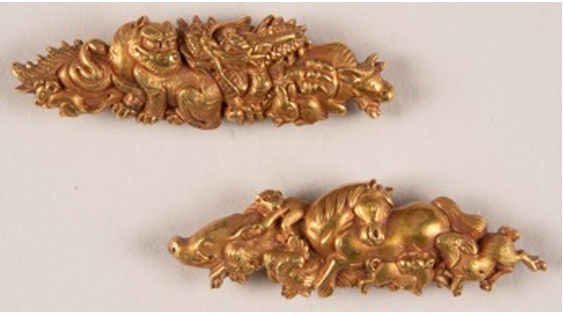-
Posts
4,094 -
Joined
-
Last visited
-
Days Won
92
Content Type
Profiles
Forums
Events
Store
Downloads
Gallery
Everything posted by SteveM
-
Glyphwiki lists 𨸩 as an alternate form of 改 https://glyphwiki.or...iki/simch-kx_t162305 posting as a pic in case the link goes dead.
-

A word about amateur polishing
SteveM replied to Brian's topic in General Nihonto Related Discussion
This is what I have heard as well. My understanding is that artificial stones are consistent in composition, and they give the polisher a much more predictable (hence, desirable) outcome, without any of the unexpected impurities of natural stones. -
https://nihontou.jp/...ugu/tuba/1180/00.htm https://nihontou.jp/...ougu/tuba/905/00.htm https://www.choshuya.co.jp/senrigan/干し網図鍔(鐔) 銘 埋忠橘宗義/鍔/宗義 https://www.bonhams....5-1868-dated-1860-2/ https://www.alamy.co...-image391579422.html
-
Fishing nets, and then probably fish drying from lines.
-
Shōhei 6, June 1st (1351). Aoi Art has a short description of this cloth (originally leather). I think there might be a couple of threads on it here on NMB as well. https://sword-auction.com/en/product/7208/鎧兜/
-

Where is the audience for Showa Gunto?
SteveM replied to Peter Bleed's topic in Military Swords of Japan
Unique Japan mistranslated that mei. It should be 兼松一則 (Kanematsu Kazunori). -
臨川堂? Rinsendō It would be the smith's "art name". But it doesn't quite fit with Shōami, as far as I know, but maybe I'm missing something.
-
In the case of the Naotane, and in the case of Guido's swords, the pair were signed and dated with the same date, indicating they were made with the intention/expectation of them being used as daisho. Having consecutive registration numbers is probably another strong factor. I think these two things are the main criteria for the NBTHK, although Guido also mentions they should have the same features (the deki).
-
Historical Armor and the History of the Military Founders of the Ii Clan by NAKAMURA Tatsuo
- 1 reply
-
- 1
-

-
Or 長光 (Nagamitsu)
-

Looking for translation on a few museum pieces
SteveM replied to Spartancrest's topic in Translation Assistance
Rakutō (East Kyōto). So Kyōto is the right location 城州愛宕郡洛東住 (Jōshū Otagi-gun, Rakutō-jū) but I can't find the smith. I also suppose its Yasutaka 保高, but Wakayama is a bit inconclusive on it. He lists two smiths using those kanji, but doesn't mention location for either, or typical mei styles. He just notes that both are late Edo. -
開眼子 (literally, "child with opened eyes") is the "art name" of the artist, Kanezui. The use of "child" in the art name, and the image of the child on the tsuba, is coincidental. The theme of Hotei with a child (particularly, a child in Chinese dress from the Tang dynasty) is an often-used motif. You can find other examples if you search for Hotei with Tang-dynasty Child (布袋唐子). I don't know the meaning or the origin (well, I guess the origin is Tang China).
-
The perfectionist in me demands I repeat the correction from the other thread. Please forgive: The theme as described on the paperwork is 雨龍 (amaryū, or rain dragon), not 雲龍 (unryū, dragon in clouds).
-
The characters look like "常之", but I could find no extant signatures of Yabu Tsuneyuki in my books, or online, to tell if this signature is a match. I did find an exquisite set of menuki from the Wakayama Prefectural Museum, that is from Yabu Tsuneyuki. (link below). Unfortunately there is no shot of the mei. The catalogue says it is signed "Yabu Tsuneyuki" (藪常之). chrome-extension://efaidnbmnnnibpcajpcglclefindmkaj/https://wave.pref.wakayama.lg.jp/news/file/33039_2.pdf
-
Looks like fake Japanese writing. Possible to get a look at the sword?
-
200 years ago this shorthand script would have been much more familiar to people. The shorthand script (grass script, kuzushi-ji, etc.) would have been a part of an educated person's upbringing. And, the poems and literature that is often referenced on these items would have been more familiar to (again) educated people. I think the modernization of Japan and standardization of hiragana pushed this kind of calligraphic script out of the mainstream.
-
Small correction: 雨龍図鐔 (tsuba with image of "rain dragon")
-
Yes, it should be a haiku. About 一花; the most obvious reading (to me) is Ikka, but it could also be read as ichige, or other readings. I doubt it is the author's name, but the way it is offset from the rest of the text does make me wonder. I'll wrestle with this a bit more. The leaf, the gourd, and the poem should all tie together.
-
一花 (ikka) on the left side, but the right side is a bit too cryptic. A mix of kanji and hiragana and hentaigana that is tough to crack (for me). Ikka means "one flower", but that doesn't help me figure out the rest. The image looks like a leaf and a gourd. Again, it may be a clue as to the poem/text, but it is beyond me.
-
I can see all of the pictures now. The "Seki" stamp on the top of the tang also identifies this as a WW2 blade.
-
The theme of the menuki is referred to as takarazukushi (宝尽くし) lit. abundance of treasures, filled with treasures. It is a theme that is also found on kimono fabrics, and features the lucky items shown on Dale's post above.
-
Hello Johnny, Your sword has the name of Fukuda Sukemitsu (福田祐光) on it. Fukuda Sukemitsu was a war-era swordsmith, so your sword is from the mid 1900s. I couldn't see all of the pictures..I got an error message halfway through. (Could be an issue with my browser?). Anyway, if you search on the internet for that name, pluse some other keywords (swordsmith, gunto, etc.) you should be able to find more info.
-
Hello Luca According to the site below it should be "sukisage-bori" (aka "sukidashi-bori"). A technique for making the main image stand out from the background, by cutting away at the surrounding surface until the main image is raised (i.e. appears more three-dimensional). https://www.touken-world.jp/tips/14655/#:~:text=「鋤下げ彫り」(すき,に表現する方法です。






